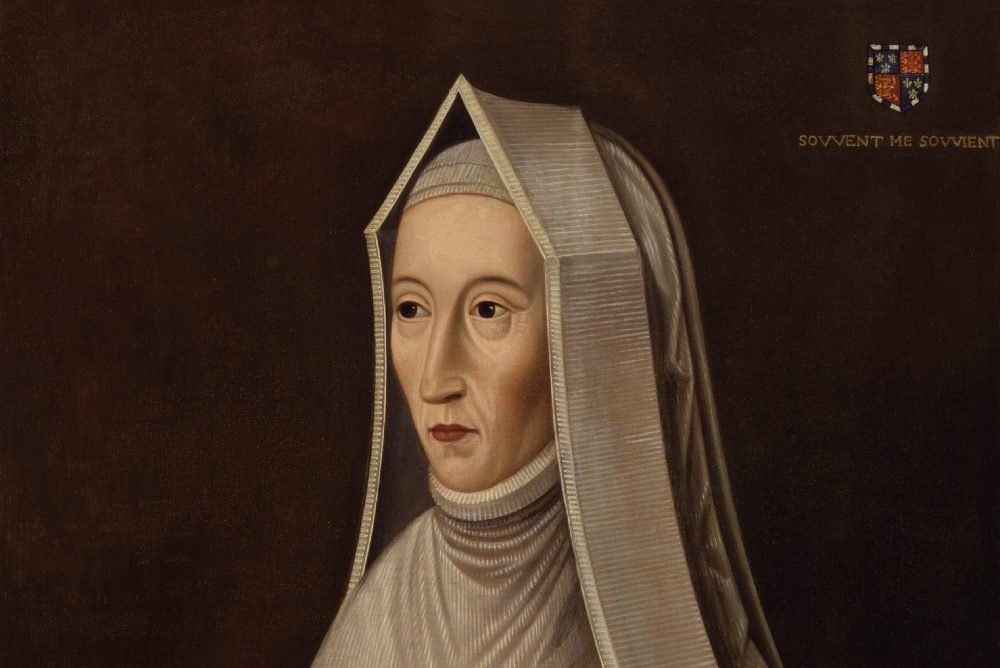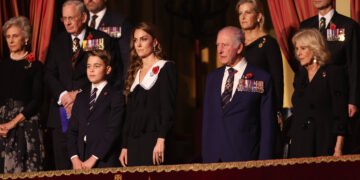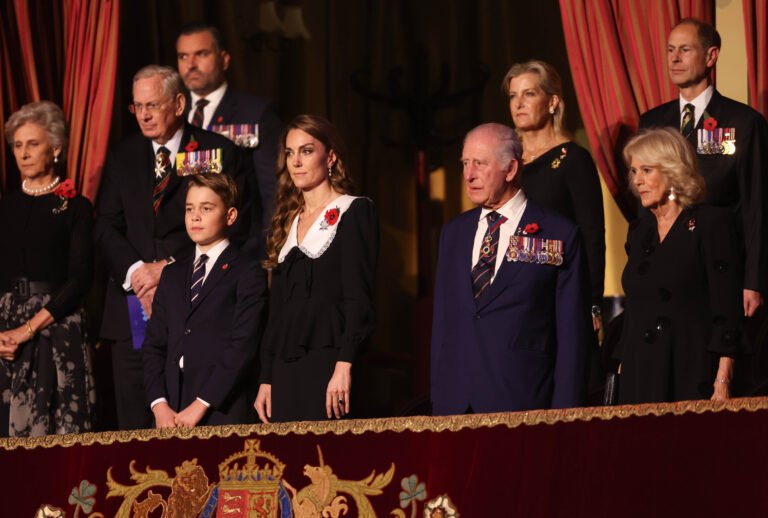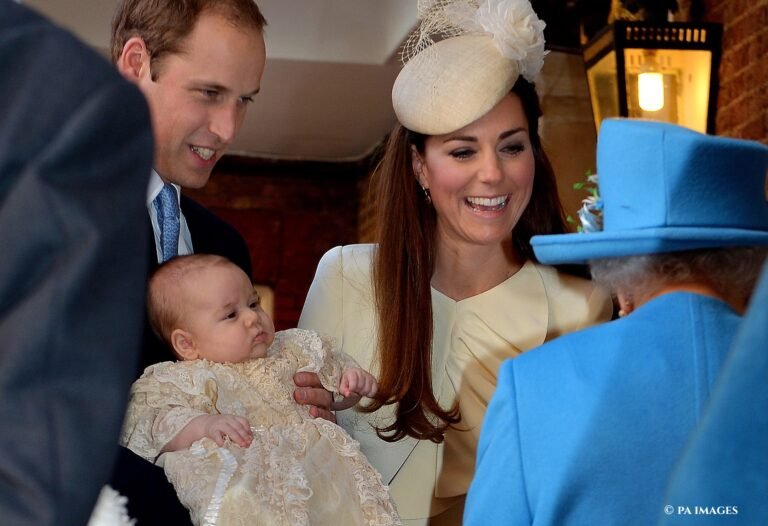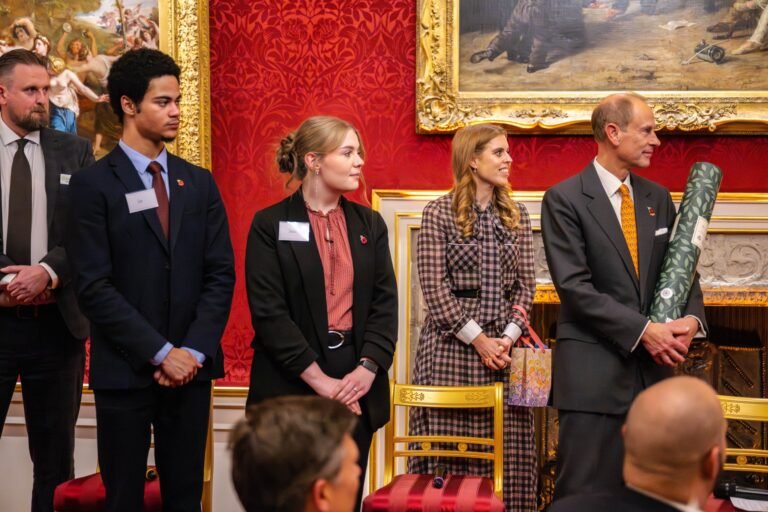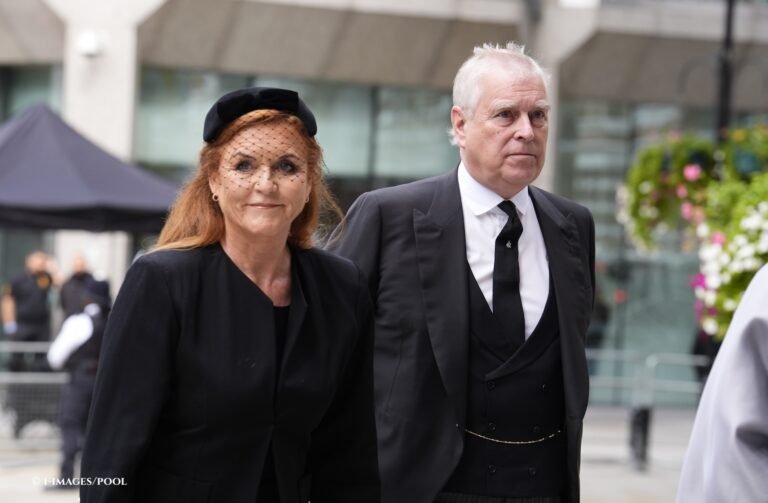Margaret Beaufort – an often overlooked and forgotten figure – played a large part in the process of making England the country it is today. She was the mother, grandmother, and great-grandmother of English Monarchs Henry VII, Henry VIII, Edward VI, Mary I, and Elizabeth I respectively.
It is often thought that her dedication to see her son on the English throne is the reason the Tudors ever came to power in the first place.
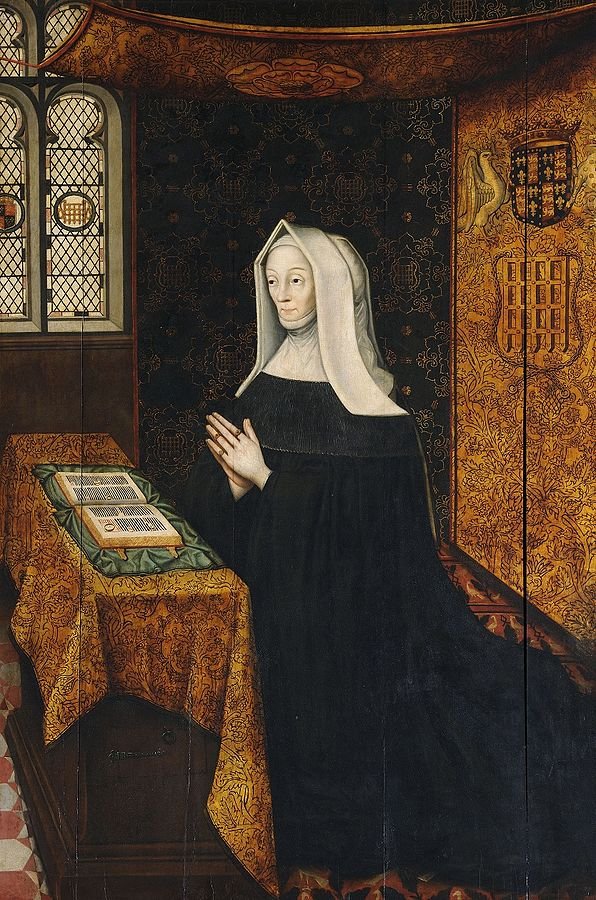
She was born to John Beaufort, 1st Duke of Somerset, and Margaret Beauchamp of Bletsoe, at Bletsoe Castle on 31 May 1443. John was related to royalty, as grandson of John of Gaunt – son of Edward III – and his mistress-turned-wife, Katherine Swynford.
Some time after her birth, her father was on his way back to England after leading a campaign in Cherbourg and Gascony under Henry VI, and soon died in 1444; his death is purported to have been suicide.
Margaret, being the descendant of an English King and having just inherited a large fortune and lands, was now more than just a marketable maiden, she was a real catch in the marriage market.
Before her father departed on campaign, an arrangement of wardship was made with Henry VI, her cousin.
But the arrangement was broken, and wardship of her lands were transferred to William de la Pole, 1st Duke of Suffolk; Margaret remained in the care of her mother, though.
Historic note: Wardship meant a child was the responsibility of the Court [of Wards] until they came of age – 21 for a boy, 14 for a girl. The Court would receive any profits from their estates and decide who the ward would marry – but wardships could be sold. Nobles would often buy a wardship to take control of these lands, benefitting from the income, and match wealthy heirs with their own children or wider family. By additionally raising the child, they were able to influence their political and/or religious beliefs as they grew, making wardship a political matter.
In 1450, Margaret was married to the Duke of Suffolk’s son, John de la Pole. The wedding is estimated to have been held between January and February 1444, when Margaret was about one year old; in this traditional arrangement, the couple would be expected to reconfirm these vows when they were of age (around 12 and 14 was common).
Soon after, however, the marriage was dissolved (allowed and not uncommon given the pair were so young). Margaret never formally recognised this as a marriage, speaking in future of only three husbands.
Henry VI granted wardship over Margaret to his half-brothers, Jasper and Edmund Tudor, sons of Catherine of Valois and Owen Tudor.
Margaret’s second marriage
The Welsh Tudor brothers were responsible for Margaret’s care over the next decade, and on 1st November 1455, she married Edmund Tudor. She was 12 years old, and he was 24 – a large age gap but again not uncommon. The King wanted her to marry Edmund to strengthen his own line, as he had no children or siblings.
This marriage, Margaret later claimed, came from divine guidance.
In that same year, a war for control of the kingdom of England broke out between the Houses York and Lancaster: the War of the Roses.
Historic note: Young marriage was commonplace, but consummation of the union was often postponed a few years to give young brides, as well as any child, a better chance of survival during and following childbirth.
As the Earl was off to fight, the marital bed was used, resulting in a pregnancy for the teenage Countess
Edmund was a Lancastrian, being related to Henry IV, and taken captive by York forces at Carmarthen, where he soon died of the plague in November 1456, leaving Margaret – now 12 or 13 and pregnant – in the care of his brother, Jasper, at Pembroke Castle.
Soon afterwards, in January, the teenage Margaret gave birth to a baby boy, Henry.
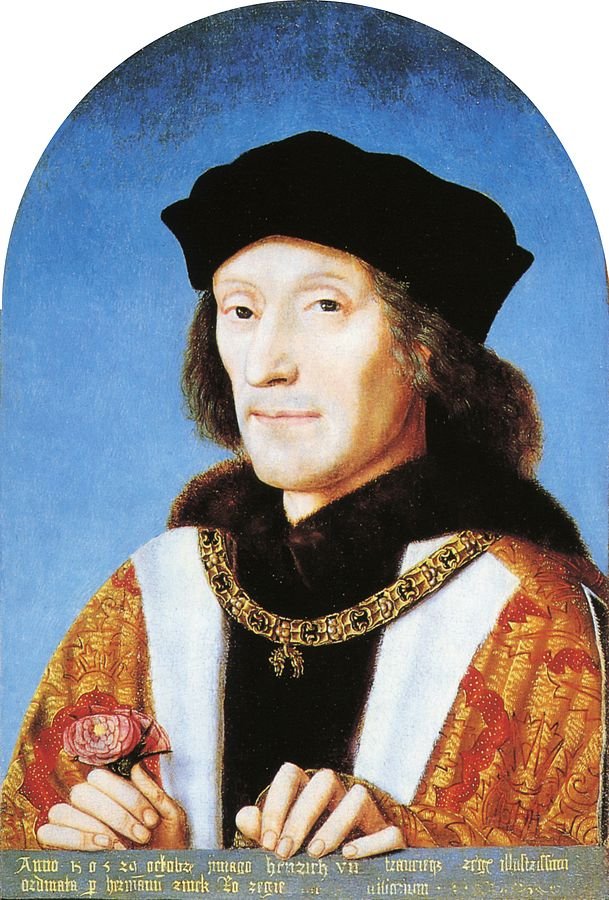
She was noted to be slight of frame ‘of so little personage’. and the birth was a difficult one; both mother and child nearly died.
It seems that Margaret was physically damaged by the birth, as she would never have another child, despite two later marriages before the age of 30.
Margaret and baby Henry remained at Pembroke Castle, until it was overtaken by Yorkists in 1461, and the castle transferred to a Lord Herbert of Raglan.
Henry, now two, was forced to live with his family in Wales, and then went on to be exiled in France with his uncle, Jasper Tudor, at the age of 14. Although Margaret and her son rarely saw each other, it is clear that the two kept in close contact with each other, and had an affectionate relationship, demonstrated by their surviving letters: ‘my dearest and only desired in this world’.
Despite the couple’s short relationship, Margaret had requested to be buried alongside Edmund at her death, but her change in status to the King’s mother meant she wasn’t deserving of a Welsh burial.
Third marriage: Henry Stafford
Indicative of her political guile and practical nature even as a teenager, Margaret realised she needed a husband to get on: the Countess remarried on 3rd January 1458, a Sir Henry Stafford, son of The Duke of Buckingham.
This appears to have been a happy match, with 14-year-old Margaret’s substantial holdings providing the couple’s main income.
Their relationship appears to have been quite happy, with wife following husband across the country for business, and perhaps even accompanying him to Parliament. We see that Margaret was eager to learn and aware that her position – even as a wealth aristocratic lady – was tenuous and she needed a husband to get on in life.
Final marriage to Thomas Stanley
Margaret, now around the age of 28, and was thus widowed a second time. In June 1472, 11 years following Yorkist victory in the Wars of the Roses and accession of Edward IV, Margaret embarked onto her fourth marriage to Thomas Stanley, the Lord High Constable of England and Baron Stanley.
As a result of her connections to her son, the exiled Henry Tudor – a distant relative of Henry VI’s – Margaret was banished from court by Edward IV. However, her marriage to Thomas Stanley, who was a loyal subject of the King’s and a cousin to the Monarch, allowed her to return to court, where she was appointed as godmother to one of the daughters of Elizabeth Woodville, Edward IV’s Queen Consort.
There were discussions of marriage between the young Tudor and one of Edward IV’s daughters, but Margaret was suspicious of these plans and instructed her son to remain on the continent.
Her marriage to Stanley was also companionate and successful; the pair were pragmatists, and Thomas trusted her to manage disputes for him. As early as 1473, there was a property dispute in Liverpool that Stanley assigned her, his brother and son to deal with, and another the following year.
After years of fairly stable life for Margaret, in 1483, Edward IV died and the English throne was seized by Richard III.
Despite her own belief in her son’s right to rule, she played the part of the doting wife and loyal subject: Margaret returned to court once more, this time in the service of the new Queen, Anne Neville; Margaret carried the Queen’s train at her coronation, such was her status.
However, while in royal service, Margaret also began plotting with the Dowager Queen, and Edward IV’s widow, Elizabeth Woodville who was in Sanctuary at Westminster Abbey, in fear of her life.
The shaky grounds on which Richard’s power stood was to be taken advantage of. Margaret realised how the people had turned on the usurper King and was almost certainly involved in an attempted rescue of the Princes in the Tower. She was also part of the group who led the Buckingham rebellion of 1483, with her former brother-in-law, Jasper.
The Duke of Buckingham – who also held a tenuous claim to the Crown – led troops agains the new King, with financial support from the Countess. Henry Tudor, in exile on the continent for his own safety, had sailed from Brittany – but arrived too late. Buckingham was executed for his treason – and Margaret was suspected of helping him.

As punishment for plotting, she was stripped of her title Countess of Richmond – it was, however, forfeited to her husband, who was still loyal to the Yorkist regime and Richard III. His standing at court prevented her from feeling the full force of the law, which would usually have been to seize her land and/or money, handing it to the Crown.
However, for the sake of Thomas’ ‘good and faithful service that he hath done and intendeth to do’ and ‘for the good love and trust that the King hath in him’, the punishment of attainder was altered… Richard couldn’t afford to alienate a trusted advisor, one who helped him invade Scotland. She was also imprisoned at home, without servants. But Stanley allowed her – or turned a blind eye – to her continued letter writing and planning with her son.
With the disappearance of the Princes in the Tower, a change of tack was needed. Plans were made between the two matriarchs (via their shared doctor, Dr Lewis Caerleon) to put Henry Tudor on the throne, deposing Richard III.
It was also agreed that Henry would be betrothed to Elizabeth of York, the eldest daughter of Edward IV and Elizabeth Woodville – a marriage which would unite the once warring houses of Lancaster and York.
Battle of Bosworth – Henry Tudor wins
Henry Tudor, still located in Wales, began to gather men to take the throne of England by right of conquest. Henry gained the support of Welsh noblemen, and began marching for London. The King mustered his troops and intercepted Henry’s army south of Bosworth Market in Leicestershire, with the two armies meeting at Bosworth Field: battle ensued.
Richard had three men for every one of Henry’s, and the military experience of battle, which the Tudor claimant did not.
Thomas, Lord Stanley, stepfather of Henry Tudor, and his brother Sir William, had been forced into gathering a militia for the King – Richard had kidnapped Thomas’ son as surety for his loyalty. Lord Stanley, ever the pragmatist, was unaffected by this move, supposedly (brutally) retorting: ‘Sire, I have other sons’.
The brothers’ reluctance to be involved saw them stay on the sidelines of the fray, along with the Earl of Northumberland, which infuriated the King. But soon after, they either decided that Henry Tudor would be more advantageous to support, perhaps as a result of Henry’s connections to Margaret – but they may have simply seen the way the battle was going.
Evidence also appears to show the Stanleys were in contact with Henry before he landed in Wales – or Sir William would have stopped Henry’s men marching through his lands. It is highly likely Margaret helped facilitate such contact with her son, to smooth his path of conquest.
In the midst of battle, and Richard III seemingly agitated, he decided to join the fray. He charged towards Henry, with the hope of killing him and ending the fight, taking out his standard bearer. Noticing that Henry’s bodyguard had separated, Thomas and William’s men surrounded Richard and killed him.
They then took Richard’s crown from his body, and crowned Henry Tudor King of England on the battlefield: this moment marked the birth of the Tudor dynasty.
Mother of the King
Stanley was rewarded with the Earldom of Derby for his support, making Margaret Countess of Richmond and Derby. But Margaret was now the mother of a King, and styled herself as Margaret R (‘R’ for Regina – Queen in Latin), and the Beaufort portcullis was adopted as a royal emblem – both a sign of affection from Henry and a recognition of his legitimacy.
As a result, she gained legal and social liberties which were not usually granted to women at the time, and was given the ability to hold property by her own right.
After Henry took the throne, he married Elizabeth of York, as promised, securing his place on the throne of England by uniting the two claimant lines.
At the time of her son’s coronation, Margaret was just 42 years old. She ‘wept marvellously’.Margaret accrued power as the King’s mother. It was noted by the Spanish and Venetian ambassadors that she was one of the people with the biggest influence they had to deal with, being more powerful than the Chamberlain, Chancellor or Keeper of the Privy Seal. She supported Henry’s intelligence network to protect royal interests even administered justice on her son’s behalf: her council heard cases and she resolved disputes on the King’s authority via a ‘privy seal writ’ and even worked on disputes in the north as well as Duchy of Lancaster business. It is clear that Henry trusted her judgement implicitly.
Historic note: In later life, Lady Margaret created a set of procedures and rules for royal births, likely inspired by her own traumatic birth experience. She was also against her namesake granddaughter marrying James IV in 1503, because she didn’t think the Scottish King would wait to consummate the marriage…
When on progress or travelling, the Countess of Richmond and Derby would be given lodgings directly next to her son, and was ever present when he was sick.
Letters Patent gave the King’s mother numerous castles, manors and lordships in Devon, Somerset, and several other counties, as well as the Manor and Castle of Corfe and the income from the profitable town of Poole, for life, and her mother’s property. When children came to the King and Queen, she was put in charge of the children’s upbringing and education, a responsibility that should have likely fallen to Elizabeth of York, the children’s mother.
The Countess was denied many of her motherly roles due to the volatile times… She didn’t arrange Henry’s education, couldn’t nurse him when ill, and he married late out of political expediency (though arranged with the help of his mother) – so supporting him during his reign was perhaps Margaret’s own way to be motherly when she could.
Henry VII made her a Lady of the Garter in 1488, tying his family back to the time of Edward III and centuries of chivalric legacy, and it is noted by biographers that Margaret had heraldic crests on almost everything she owned. Her life’s work had been leading to the accession of her son, and she was going to promote it any way she could.
In April, 1509, King Henry VII died, and Margaret was made the executor of her son’s will. She was also responsible for the organisation of the funeral, where she was given precedence over all ladies of the Royal Family (Elizabeth had died in 1503 following childbirth), as well as the coronation of her grandson, Henry VIII.
Margaret’s renowned piety
One of the first impressions a viewer gets of Margaret Beaufort is her great piety. In all the paintings that survive of her today, she is either seen in prayer, or holding a Bible whilst in garbs traditionally worn by widows. This nature is mirrored in the Countess’ translation of a number of religious texts from French, including the ‘Imitation of Christ’.
She had buyers of books sent to Paris on her behalf, and commissioned booked from famous printers, like Caxton and de Worde.
 By Alexander Williams – Own work, CC BY-SA 4.0, Link
By Alexander Williams – Own work, CC BY-SA 4.0, Link
Although no contemporary paintings of Margaret survive, there are a few sources from that reflect the idea of her piety: at her funeral sermon, her chaplain and confessor John Fisher remarked that, ‘she was bounteous and liberal to every person of her knowledge or acquaintance. Avarice and covetice she most hated, and sorrowed it full much in all persons.’
She rose at 5am to hear four or five masses before breakfast according to Fisher. Her days were also filled with time dedicated to prayer, meditation and reading, and even as she aged suffering with arthritis, her devotions were unwavering.
Despite her husband still being alive, the Countess took a vow of chastity in 1499, which Lord Stanley agreed to.
Margaret died in the Deanery of Westminster Abbey on 29th June 1509, one day after King Henry VIII turned 18. Her life’s work was complete.

She was buried in the Henry VII Chapel at Westminster Abbey, between the tombs of William II and Mary II, and her estate was valued at £15,000, making her a vey rich Tudor woman.
Margaret was known during her life for her piety and philanthropic actions. She is perhaps best known for founding Christ’s and St. John’s Colleges at Cambridge University, both of which bear the Beaufort portcullis in their crests.
Margaret’s devotion to her son and to the success of the Tudor dynasty is undoubted. She was dedicated to seeing her son on the English throne, and thus, was important to the founding of the Tudor dynasty – a dynasty that’s responsible for creating the England known today.

